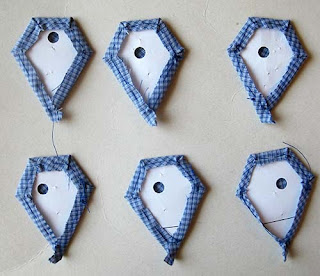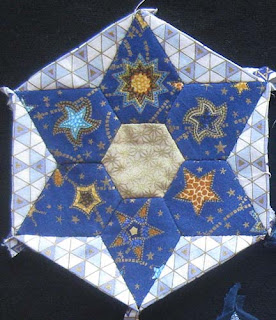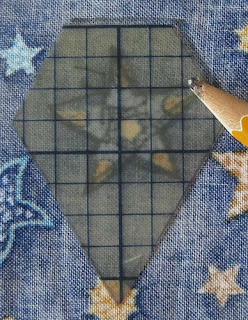
I won't say it was easy. I won't say it was fast. I don't know what I'm going to do with it. But I will say that I had a great time making it in a hotel room!
The quilt world has its fads, and one of the most astonishing now is using English Paper Piecing techniques, aka EPP, to make dazzling hexagon-based kaleidoscopic quilts.
EPP usually means hand-basting fabric over a paper or cardstock shape, then hand-stitching the shapes together. It dates back to 18th century England, and has made a roaring comeback, in large part because of Dutch quilter Willyne Hammerstein. Her books, Millefiore Quilts and Millefiore Quilts 2, cost a minimum of $40 - but are so worth it:
Credit for the EPP resurgence also goes to Katja Marek, a quilt shop owner in Kamloops, British Columbia, who wrote The New Hexagons: 52 Blocks to English Paper Piece.
The book shows how to make 52 decorative hexagon blocks. Once you have the pattern book, if you go to this page on her website, Katja shows how to join the blocks together into "rosettes" which can then be arranged to become a Hammerstein-esque millefiore quilt. The image below is one example.
I'd read about historic EPP quilts for years, but wasn't tempted. Then, I started noticing these new geometric quilts...I 'liked' Marek's FB page; quilts made by her disciples started appearing in my Facebook newsfeed. I was seized.
Thus, when my husband invited me to travel with him to a conference in Aspen, Colorado in March, I decided this would be the perfect opportunity to try EPP. And I'm so glad I did. Though tricky, fussy, and slooooow, EPP is also deliciously meditative, relaxing, and put me directly into The Zone.
PLAN YOUR RETREAT
It's a good idea to go to a hotel room, because otherwise, at home, your sewing machine will stare at you with its big sad expensive empty bobbin eyes, pleading with you to speed things up by zigzagging your EPP pieces together with invisible thread! Which, to me, defeats the purpose - EPP is all about taking the slow boat!
So consider marrying or befriending someone who will be travelling to a conference soon, in a field in which you are illiterate (physics in my DH's case), so you won't be tempted to attend their meetings, and will instead experience the glorious bliss of sitting in your hotel room and hand-sewing slow, dangerous angles.
WHAT TO PACK
1. A Bible: If you're an EPP beginner, I strongly recommend All Points Patchwork, by Diane Gilleland, my new BFF (I've never communicated with her, but after five days in a hotel room with her book, I feel we are on a first-name basis.) This 200+ page book is packed with priceless advice on the myriad details of EPP.
2. Paper templates You have to choose a formation of shapes. I liked the star on the cover above, but wanted it simpler. Since there wasn't a pattern for that specific configuration in the book, I drew it in in my graphic design program, starting with a 1" per side hexagon in the center. (Diane shows many different ways to draft shapes accurately - you don't have to use a computer!)
The dots mark the centers of each patch, which I added after the retreat, to help with placement. I crammed two full formations onto a single page, plus two more partial formations to make extra pieces.
Then I printed out three identical pages onto cardstock, and carefully cut the shapes apart.
If you don't want to draw and/or cut accurate pieces, no worries! EPP packs are sold in quilt and fabric stores, and many places online, including the fascinating and educational paperpieces.com website. They're cheap! If you just want to download pieces and cut them out yourself, there are lots of downloads online, including these free paper pieces with inspirational quotes!
Diane told me to punch a hole in each template. That makes it easier to remove them at the end of the process, by inserting a crochet hook or other implement.
She says to poke holes in the middle, but over time I preferred to punch them a little off to one side, so that I could put a pin through the center of the template for precision placement of printed motifs. I sorted my templates into bags.
3. Fabrics that go together. I packed about 12 pieces of fabric, ranging from strips to 10" pieces, for a 5-day trip. Blues were the focus, with highlights of white, gold, and silver. Many are from my stash of elegant Judaic prints - Passover is coming, maybe I could make something for the holiday. I included geometrics as well as flowy designs. Important: Select a range of values, lights, mediums and darks.
4. Sewing Supplies: Sharp scissors; threads in colors that match the fabrics; slim needles; slim pins; (mine weren't); a thimble; a paper clip or two.
Optional: If you will check your baggage, put a larger fabric scissors into your checked suitcase. The small sharp applique scissors above that I used are allowed in airplane cabins, but aren't as good at cutting fabric shapes as larger scissors.
5. Optional: Your laptop, and maybe a subscription to The Quilt Show, or Netflix, Hulu, etc.
6. Optional: An iron. If your hotel doesn't have an ironing setup, you can pack a travel iron - but it's not mandatory. People do EPP on buses, in doctor's waiting rooms, and at meetings, where setting up an ironing board would be considered peculiar. Ironing makes things a bit easier and faster.
What I wish I had brought, but also optional:
7. A non-permanent glue stick
8. Magnifying eyeglasses. EPP involves tinier stitches than I'd anticipated.
WHEN YOU ARRIVE
Compete with your roomate to establish a beachhead on the desk with the best lighting!
MORNING, THE FIRST DAY
After an overpriced breakfast buffet ($23), kiss your travelling companion a fond farewell, or shake their hand vigorously (depending on your relationship), and wave as he or she heads off to their morning meeting. Have fun, honey!
Alone at last! Do a happy dance, because that's all the exercise you're going to get for the next few hours! Sit at your desktop, turn on your laptop (in my case, I binge-watched episodes of The Quilt Show). Your blood pressure is about to plummet.
I recommend you start with hexagons. They're the easiest shapes to baste. I pinned or paper clipped the fabric to the template, and cut a generous quarter inch all the way around (Over time, I learned: The bigger, the better, within limits. A half inch is good.)
Fold the edges in. Ironing them inward makes it go more smoothly. Sometimes I pinned, sometimes I paperclipped for the first several sides.As you fold each edge, stitch all the way around with large basting stitches. You'll need to take an extra tacking stitch at each corner.
Diane's book offers priceless tips about tacking, easy knots that I'd never known about, and advice about when you should or should not penetrate the paper and the front with your basting stitches. For templates as small as mine, I didn't need to penetrate the cardstock.
Precise placement of printed motifs adds an extra layer of complication. I didn't arrive at the hotel well prepared for fussy cutting. I'll show you what I wish I'd done lower down.
Once you've basted a hexagon, you're qualified to move on to shapes with sharp points, especially, for my formation, the half-diamond, half-hexagon shape that Diane calls a "jewel".
The acute tips are challenging. One of the options that Diane suggests is to push both seam allowances to one side. She calls the resulting angles "flags". In the picture below, the flag is at the bottom, pointing left.
During my retreat, I didn't pay enough attention to Diane's advice to be consistent with the direction of flagged seams. If, within the same project, you iron some seams clockwise, and some counterclockwise, you're going to have trouble. What am I talking about? Look at the bottom tips in the "jewel" pieces below.
Can you see what's wrong with this picture? In the top row, all the flags point right. In the bottom row, they point left. Three of them are going to have to change in order for the pieces to come together smoothly.
Consistency turned out to be especially important for the outer wide triangles in my formation. In the image below, they're done correctly. The right tip flags are pointing down, the left tip flags are pointing up. For the non-acute angles - like the top center of the triangle - the direction of the seam allowance is not as important.
Before sewing pieces together, it's important to check whether you like the fabric combinations you chose. Below, I rejected this central hexagon.
I picked the one below. Then I tested the pieces that surround the star. I decided the scrollwork fabric was too busy.
Here's what I chose:
Once you've made all the pieces, it's time to sew them together. First, I attached each jewel at the base to the central hexagon.I used a whipstitch (Diane explains it and alternatives.) You end up smushing the cardstock in various directions, but it's not difficult. The stitching turned out tinier than I expected, and I wished I'd brought my magnifying headgear.
The next step is to stitch up the seams between each jewel. Last, stitch in the outer "background" triangles. The huge advantage of EPP with shapes like these is that y-seams are a breeze.
Here's the back when everything was sewn together. I didn't remove the outer jewel or triangle papers until much later.
My DH's conference was only in the morning and evening, so in the afternoon, he pried me from my chair, and then we staggered - just a little altitude-sick - around glorious Aspen. As wonderful as aspen-trees-with-eyeballs are...
..and as thrilling/terrifying it was for two acrophobes to take a gondola to the top of the mountain....
(AIEEEEEEE! We didn't ski down. We ate pizza and drank a beer to fortify ourselves for the terrifying gondola return trip).....I nonetheless longed to return to the pleasure chamber that was our EPP infested hotel room.In 3.5 hours per morning, for four days of the conference, I was able to finish the following 5 stars:
Cosmic star:
Hebrew star:
Solid star:
Fan star:
Star star!
Back home, I found it hard to stop. So I completed a bunch more, including the pomegranate (tulip?) star:
African star:
Dove star:
Gold star
Plus two stars made from upcycled mens' shirts
They all came together MUCH faster at home, because (1) I was getting better at it, (2) I used a glue stick, (3) I did more ironing, and (4) I found a reliable system for fussy-cutting the prints.
Fussy cutting means precise placement of the print that appears on the shape. In my hotel room, I mostly eyeballed it, which takes time and doesn't work perfectly. Once home, I solved the problem by making myself one plastic template for each different shape. Below, I'm tracing a cardstock jewel template onto gridded plastic.
Here are the three templates I made.I wrote "F" on them for "front" - to avoid confusion with backwards designs.
Start out by scouting a fabric for a good location.
Gaze appreciatively at it through the template plastic.Using a soft pencil, crayon, or chalk marker, trace the outline of the printed motif on the front of the plastic. Here, I drew over the star.
Now the template looks like this: (I should have put that F in a lower corner, with a permanent marker.)
Flip over the fabric, and the template. Find the same location from the back.
Trace around the outer edges of the template onto the fabric, with a soft pencil or a fabric marker . I didn't use a Sharpie or permanent marker because I worry it might leach through to the front.
There's the outline for your paper template.
Cut about a half inch away from the lines, unlike the photo below. Place your cardstock template within the lines.
Paper clip or pin it in position.
Now you can start folding the edges in and stitch-basting. If you're - perish the thought - in a bit of a hurry, consider glue-tacking the corners. Specifically (when I got home), I aimed for a little smear of glue on the right side of the folded-over portion. In the photo below, see that little yellow-and-brown splotch on the upper right? That's the approximate location on each flap where I aim the glue stick.

I try to minimize the amount of glue will wind up on the cardstock. The glue does make it harder to remove later, and may tear the cardstock so it can't be reused.
If you don't mind tearing your templates, and use a lot of glue, you won't even need basting stitches.
Here's a finished jewel.
Once there's six, I can erase the pencil marks on the plastic template and start over with a new print.
When I had seven completed stars, I sewed them all together, to make the traditional pattern known as "Seven Sisters." The front is the first photo on top of this blog post. Here it is from the back, before I removed the papers. Cool, no?
Because I was inconsistent about the way I'd pressed the flag tips, some of the intersections were messy, like this one.
I may yet take this formation apart, fix the seam tips, and reassemble it again.
Of course, my stars are kindergarten compared to the amazing EPP projects out there. Diane's book takes you from beginners to more advanced projects, including curved shapes, distorted shapes, even 3D shapes. She offers a great deal of advice and diagrams that will help you design your own shapes and formations. And, of course, if you google EPP, you are going to be blown away as I was with zillions of possibilities!
NOTE I have no financial affiliation with any of the companies, individuals, designers, publishers, cities, or ski lift operators mentioned in this blog post!
UPDATE: A thoughtful reader directed me to another fantastic EPP site, https://thediyaddict.com/. Original designs by Karen Tripp, tutorials, and kits, including a kit to make a Hammerstein Millefiore quilt.


























































This is gorgeous, Cathy. Thank you for sharing the step along your journey to sych a creation. I love to do EPP, and this is very special. PJR
ReplyDeleteThank you so much, Pamela. I didn't expect to love it so much. I think I'm hooked!
DeleteI'm longing to do some slow work and as soon as I get through the pile of obligations, I will join you in what may become an obsession. Your photos and instructions will be a great help. As always, Cathy, your humor-laced writing is the co-star. Thank you!!
ReplyDeleteSherry, beware, it's SO addictive! Thank you for the nice comment!
DeleteThanks for sharing your work. Looks lovely. Would love to be in Aspen--skiing!
ReplyDeleteOf course you're a skier, Vivian! The last time my DH skied, he needed an ACL transplant!
DeleteGreat post about EPPs, Cathy! Thanks for good descriptions and all the pictures. When I get over my obsession with Karen K Stone's Indian Orange Peel design with all its little pointy places, I'm ready to try EPP. In fact, Karen has a new pattern out creating complicated designs using EPP!
ReplyDeleteMartha, thanks for the info! I looooove Karen Stone's patterns, though I've never had the courage to do one. I'll go look for her EPP pattern! Much appreciated!
DeleteGood job on your 1st EPP project. Diane's book is the bomb and has so much great information. Willyne Hammersteins' books are still available through Quiltmania, the publisher or at www.paperpieces.com. If you are looking for a new project, check out Karen Tripp's Mischief pattern at www.thediyaddict.com Happy Epping.
ReplyDeleteThank you so much, Happy! The DIY addict site is wonderful! And so is Quiltmania! Much appreciated!
Delete